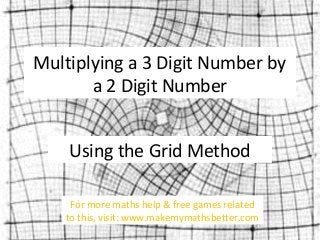
Multiplying a 3 Digit Number by a 2 Digit Number Using The Grid Method
- 1. Multiplying a 3 Digit Number by a 2 Digit Number Using the Grid Method For more maths help & free games related to this, visit: www.makemymathsbetter.com
- 2. First, split the 3 digit number into hundreds, tens and units. For example; 642 is split up as 600, 4O and 2
- 3. First, split the 3 digit number into hundreds, tens and units. For example; 642 is split up as 600, 4O and 2 275 is split up as 200, 70 and 5
- 4. First, split the 3 digit number into hundreds, tens and units. For example; 642 is split up as 600, 4O and 2 275 is split up as 200, 70 and 5 356 is split up as 300, 50 and 6
- 5. Then, split the 2 digit number into tens and units For example; 67 is split up as 6O and 7
- 6. Then, split the 2 digit number into tens and units For example; 67 is split up as 6O and 7 89 is split up as 80 and 9
- 7. Then, split the 2 digit number into tens and units For example; 67 is split up as 6O and 7 89 is split up as 80 and 9 36 is split up as 30 and 6
- 8. Then put the 3 digit number on the top part of the grid and the 2 digit number, that you are multiplying by, down the side of the grid. For example: 642 x 89: x 80 89 9 600 40 2
- 9. Then put the 3 digit number on the top part of the grid and the 2 digit number, that you are multiplying by, down the side of the grid. For example: 642 x 89: x 600 40 2 80 89 9 Then multiply the hundreds (600) by the tens (80): x 600 80 48000 9 40 2
- 10. Then put the 3 digit number on the top part of the grid and the 2 digit number, that you are multiplying by, down the side of the grid. For example: 642 x 89: x 600 40 2 80 89 9 Then multiply the hundreds (600) by the tens (80): x 600 80 40 2 48000 9 Then multiply the tens (40) by the tens (80): x 600 40 80 48000 3200 9 2
- 11. Then multiply the units (2) by the tens (80): x 600 40 2 80 48000 3200 160 9
- 12. Then multiply the units (2) by the tens (80): x 600 40 2 80 48000 3200 160 9 Now multiply the hundreds (600) by the units (9): X 600 40 2 80 48000 3200 160 9 5400
- 13. Then multiply the units (2) by the tens (80): x 600 40 2 80 48000 3200 160 9 Now multiply the hundreds (600) by the units (9): X 600 40 2 80 48000 3200 160 9 5400 Then multiply the tens (40) by the units (9): X 600 40 2 80 48000 3200 160 9 5400 360
- 14. Then multiply the units (2) by the units (9): X 600 40 2 80 48000 3200 160 9 5400 360 18
- 15. Then multiply the units (2) by the units (9): X 600 40 2 80 48000 3200 160 9 5400 360 18 Finally, add the 6 answers together: 642 x 89 = 48000 + 3200 + 160 + 5400 + 360 + 18 = 57138
- 16. Then multiply the units (2) by the units (9): X 600 40 2 80 48000 3200 160 9 5400 360 18 Finally, add the 6 answers together: 642 x 89 = 48000 + 3200 + 160 + 5400 + 360 + 18 = 57138 For more help with your maths, try my book: mastering multiplication tables on amazon.com
